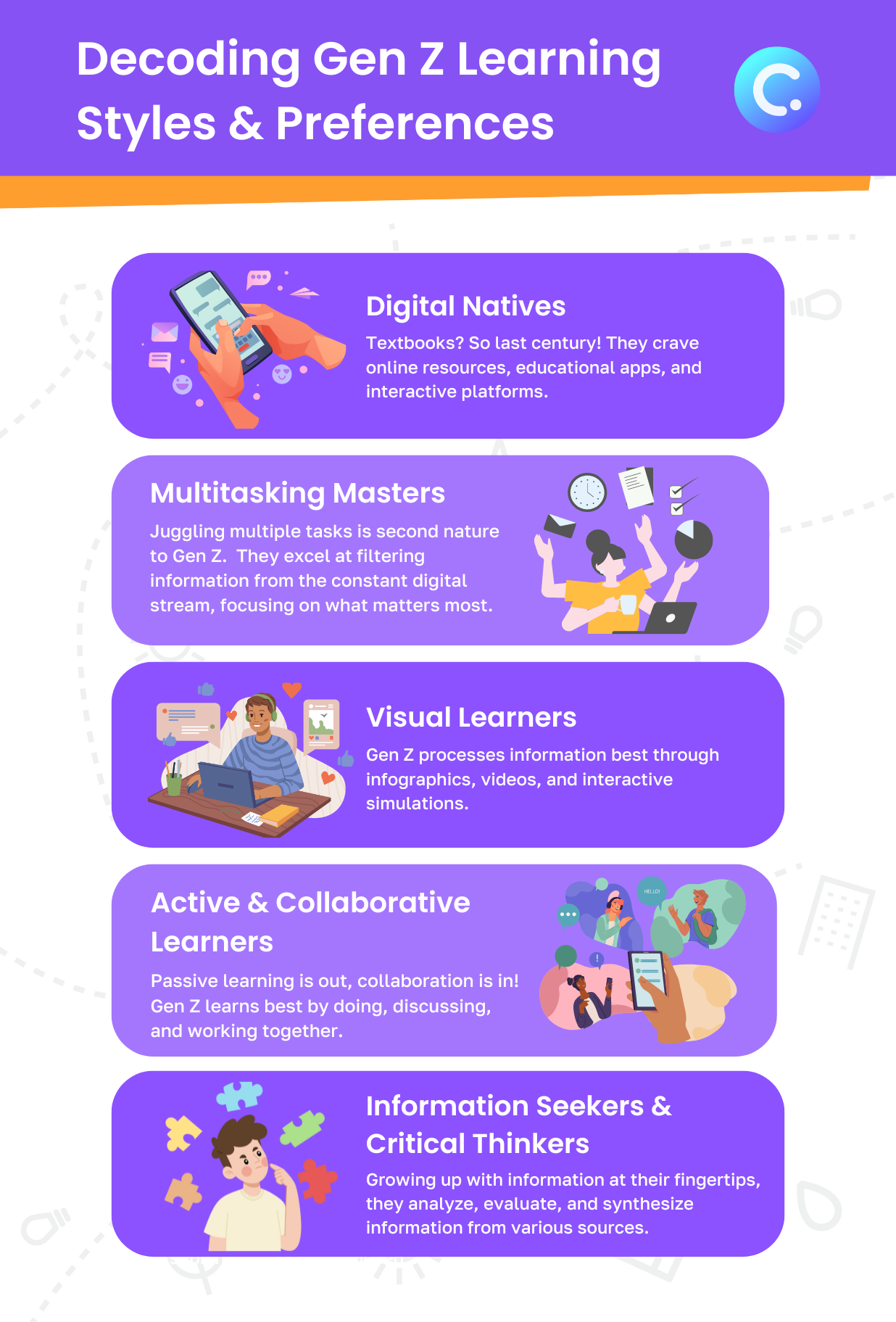Generation Z, those born roughly between the mid-1990s and early 2010s, are the digital natives taking classrooms and workplaces by storm. As educators, it’s crucial to adapt teaching methods to cater to the distinct needs and preferences of this generation. In this article, we’ll highlight the intricacies of the Gen Z learning style, explore effective teaching strategies, and provide insights on engaging Gen Z students in the classroom with the help of EdTech tools.
Understanding The Gen Z Learning Style
Gen Z students are constantly connected, with information at their fingertips. Like Gen Alphas, they thrive on visual content, short-form videos, and interactive experiences. Their attention spans may be shorter, but their ability to multitask and navigate the digital world is unparalleled. Generation Z also prioritizes social justice and collaboration, seeking learning experiences that are relevant and impactful.
To effectively engage Gen Z students, educators must first grasp their unique learning styles and preferences. Here’s a deeper dive into the characteristics that define Gen Z learners:

Digital Natives
Born and raised in a world saturated with technology, Gen Z students are innately comfortable with digital tools and platforms. They view technology as an extension of themselves, seamlessly integrating it into their learning process. Textbooks and traditional lectures might feel outdated to them. Instead, they gravitate towards online resources, educational apps, and interactive platforms that cater to their digital fluency.
Multitaskers
Gen Z students are masters at juggling multiple tasks and information streams simultaneously. They’ve grown accustomed to the rapid-fire pace of social media and digital communication. However, this doesn’t necessarily equate to a shortened attention span. They excel at quickly filtering information and focusing on what’s most relevant.
Visual Learners
Gen Z thrives on visual content. They process information more effectively through images, infographics, videos, and interactive simulations. Traditional text-heavy learning materials might feel overwhelming or dull.
Active and Collaborative Learners
Unlike passive learning styles, Gen Z students crave active participation and collaboration. They learn best by doing, discussing, and working together. This aligns perfectly with the growing focus on project-based learning and student-centered classrooms.
Information Seekers and Critical Thinkers
Surrounded by information from the moment they were born, Gen Z students are masters of online research. But their skills go far beyond simply finding information. They are critical thinkers who value the ability to analyze, evaluate, and synthesize information from various sources.
By understanding these characteristics, educators can create a learning environment that caters to Gen Z's strengths and preferences. This will not only improve engagement and motivation but also empower them to become self-directed, lifelong learners.
Bridging the Gap for Successful Gen Z Engagement
Educators face a unique challenge when it comes to Gen Z students: engaging a tech-savvy generation with limited attention spans while also fostering critical thinking and information literacy skills. Bridging the gap between traditional methods and Gen Z’s digital preferences requires creativity and a shift in approach.

Gen Z thrives in the digital world, but critical thinking skills are essential to navigate the vast amount of information online. Educators must equip them to be discerning consumers of information. Fact-checking, evaluating sources, and understanding how information is presented are 21st-century literacy skills.
Another challenge is making learning relevant to Gen Z. They crave to understand how what they learn applies to their goals and the world around them. Incorporate case studies, simulations, guest speakers from relevant fields, or projects that tackle real problems. Help them see the bigger picture and the impact they can make.
Here are some points on how you can transform your classroom to resonate more with the Gen Zs:
👩🏻💻 Engaging Gen Z Digital Natives with EdTech: Incorporate technology seamlessly to hook these digital natives. Interactive whiteboards, educational apps, gamification, game-based learning and quizzes can breathe new life into lessons.
📝 Engaging Gen Z Multitaskers with Microlearning: Try these microlearning apps that can deliver content in short, digestible chunks, like micro-lectures or interactive modules. Many platforms also offer personalized learning paths, catering to individual learning styles and paces.
📸 Engaging Gen Z Visual Learners with Multimedia: Speak to Gen Z’s preference for visuals and spark Gen Z’s creativity with tools and projects that allow them to create interactive presentations, infographics, or even short videos to showcase their understanding of a topic. This not only deepens learning but fosters communication and digital literacy skills.
🤝 Engaging Gen Z Active Learners with Active Learning and Collaboration: Move beyond passive lectures, as that won’t be enough to stimulate Gen Z students. Project-based learning, debates, and role-playing activities – all these strategies encourage active participation, collaboration, and communication skills.
🌎 Engaging Gen Z Information Seekers with Real-World Application: Help students connect the dots with the outside world to strengthen critical thinking among Gen Z students. Case studies, guest speakers, and simulations using AR and VR, immersive technologies can bring abstract concepts to life, can demonstrate the practical value of what they’re learning.
Top EdTech Tools to Unlock Gen Z Engagement

Gen Z’s comfort with technology presents a golden opportunity for educators. The right EdTech tools can transform your classroom into an engaging and interactive learning environment, perfectly suited for their digital-native preferences. Here are some EdTech tools teachers can incorporate into their lessons so they can connect more with their Gen Z students.
| Category | Tool | Description |
| Quizzes and Gamification | ClassPoint | Makes presentations interactive with quizzes and gamification elements like award stars and leaderboards. |
| Gamification | Gimkit | A game-based learning platform for live game shows where students answer questions to earn points and power-ups. |
| Quizzes and Gamification | Quizizz | Turns review sessions into friendly competitions with gamified quizzes and leaderboards. |
| Micro & Personalized Learning | Khan Academy | Offers a vast library of free micro-lectures and practice exercises. |
| Micro & Personalized Learning | Duolingo | Gamifies language learning with short, interactive lessons and personalized learning paths. |
| Micro & Personalized Learning | SC Training (Formerly EdApp) | Provides microlearning modules with gamification and spaced repetition for better retention. Also has an authoring tool for teachers. |
| Content Creation | Canva | User-friendly platform for creating visually appealing presentations, infographics, and posters. |
| Content Creation | Biteable | Online animation tool for creating short explainer videos with pre-made templates. |
| Content Creation | Powtoon | Easy way to create animated presentations and explainer videos. |
| Collaborative Learning | Google Classroom | Free platform for creating online classrooms, sharing assignments, and facilitating discussions with real-time collaboration. |
| Collaborative Learning | Padlet | Online bulletin board tool for brainstorming ideas, sharing resources, and collaborating virtually. |
| Collaborative Learning | Mentimeter | Interactive platform for creating polls, quizzes, and word clouds for real-time participation. |
| AR & VR | Quiver | AR coloring book app that brings characters to life in 3D. |
| AR & VR | Merge Cube | AR tool that transforms a cube into a portal for interacting with virtual objects in 3D. |
| AR & VR | ClassVR | VR headsets that bring the world into the classroom with virtual reality field trips. |
For more EdTech tools and digital integration tips, download this EdTech in Schools 101 White Paper 👇
EdTech in Schools 101: A Roadmap to Improve Digital Integration and Digital Literacy in Education
Discover the latest insights and strategies for successful integration of EdTech in schools worldwide. Download now for expert guidance, practical tips, and case studies.
Final Thoughts
As educators, it’s essential to recognize and adapt to the unique learning styles of Generation Z students. By understanding their preferences for interactive, technology-driven learning experiences, educators can create engaging and meaningful educational opportunities that inspire and empower Gen Z learners. By embracing innovative teaching methods, leveraging technology, and fostering collaborative learning environments, educators can ensure that Gen Z students are equipped with the skills and knowledge they need to succeed in an ever-changing world.
